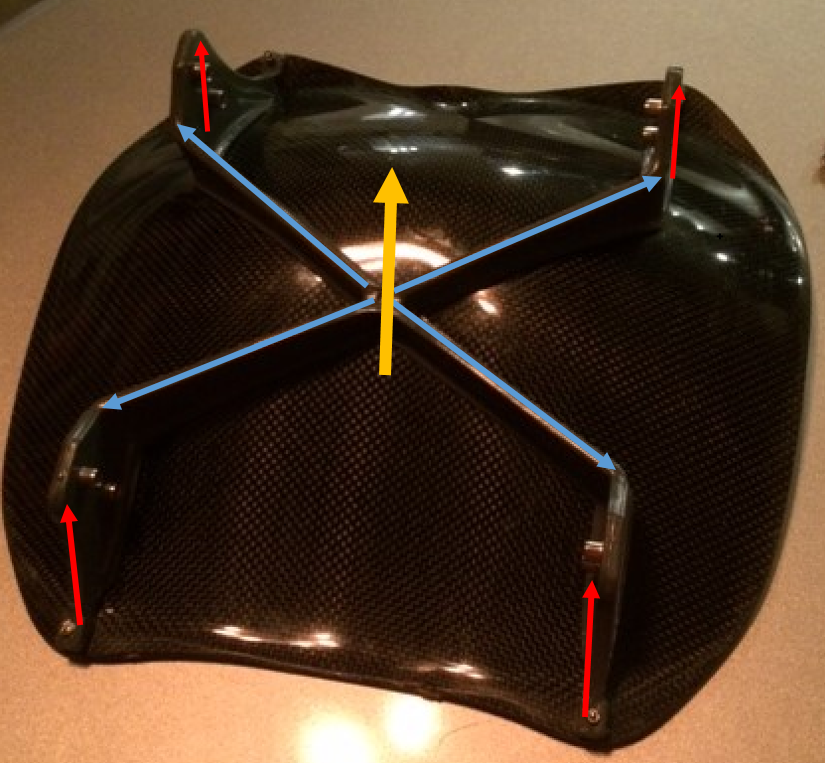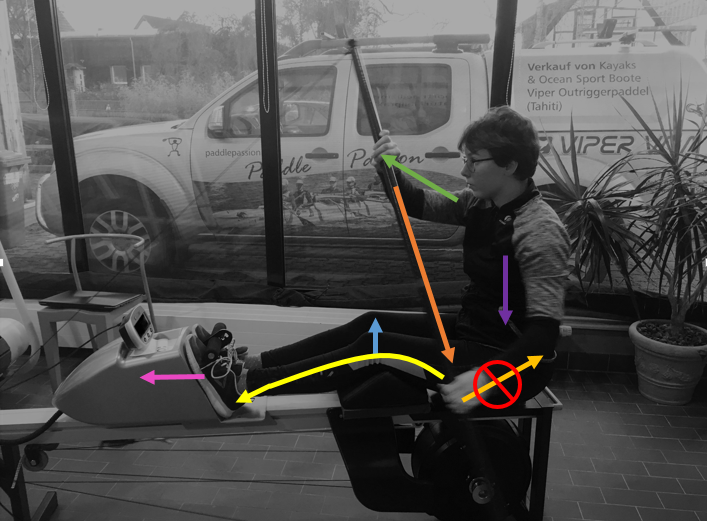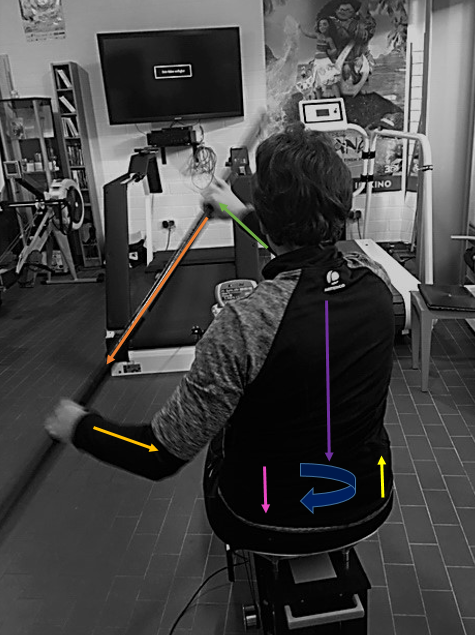FORCES STUDIES
Diagrams and explanations
First we did an approach to the forces that goes through the kayak and the paddle. Then we continue to study the forces in Katharina’s body and we ended studying the forces in the actual seat to see what was the better structure needed.
FORCES THROUHG THE KAYAK
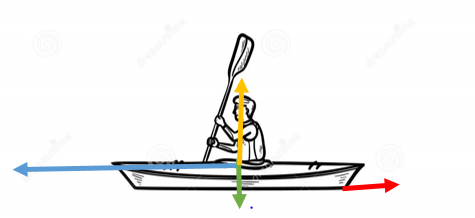
Normal force: any object, wholly or partially inmersed in a fluid, is buoyed up by a force equal to the weight of the fluid displaced by the object.
Linear displacement: uniform accelerated movement
Weight force: Katherina´s weight + kayak´s weight
Force of friction: resistence of water against the movement (also there is going to be another force of friction because of the resistence that the air is going to make against the kayak and the body of Katherina)
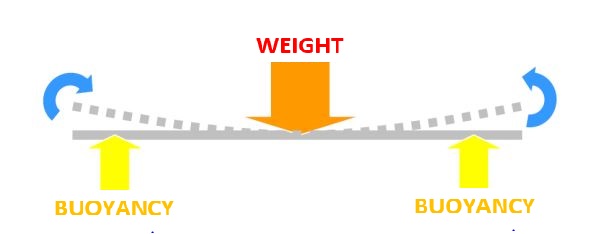
There are two major forces at work on a kayak at rest in the water. The weight of the paddler, his gear and the boat all add up to a force pushing down towards the center of the earth. This weight is supported by an equal and opposite force from the buoyancy of the water, which pushes up. It is the interaction of these two forces that are involved in stability. The relative distribution of the forces will determine whether a kayak is stable or not.
It’s combine all the weights in a kayak into a "center of gravity" (CG) or "center of mass" (CM) and all the buoyancy forces into a "center of buoyancy" (CB).
This force is equal to the sum of the weight of the kayak plus the weight of Katharina (52+60), multiplied by the gravity, which is a total of 1097,6 kilograms.
BUOYANCY CURVE
GRAVITY CURVE
RESULT
If some new condition comes along to disrupt the equilibrium, such as wind or a wave the kayak will start to tip. As you tip, your CG moves in the direction you're tipping. Unless the CB moves in response, your weight will be hanging out beyond the buoyancy forces supporting you and you will capsize. In a stable kayak design, the action of tipping the boat rearranges the buoyancy forces to move the CB in the direction of the tilt beyond the CG, thus forcing the kayak upright again. In a stable boat the center of buoyancy moves side to side faster than the center of gravity.
FORCES THROUGH THE PADDLE

Force of friction: resistence of water against the movement (also there is going to be another force of friction because of the resistence that the air is going to make against the kayak paddle)
Weight force: weight of the paddle
Centrifugal force: the apparent force that is felt by an object moving in a curved path that acts outwardly away from the center of rotation.
Centripetal force: the force that it is needed to keep an object moving in a curved path and that is directed inward toward the center of rotation.
FORCES IN KATHARINA'S BODY
We are going to do an analysis step by step of the forces that appear while Katherina is paddling. First of all we are going to set the axis of the hips as the reference axis. It is important to remember that Katherina´s weight is going to be involve in all the diagrams highlighted in purple.
IMAGE 1 & IMAGE 2
The first situation that is going to be analysed is when the right hand is above head level. In this situation the movement goes as we are going to explain. The right arm is going to be extended pushing forward the paddle on the right side while the left side is going backwards but without a pulling force being involve, so the movement in the left side is going to be passive. At the same time the left knee is going to be slightly elevated by the passive force that is transmited from hips to feet. And feet will trasnmit the force to the kayak making it moving forward through water
The second diagram is exactly the same as the previous one but with another perspective.
IMAGE 3
Here we have the back side. We can see that the forces in the arms are the same that we have explain in the previous diagrams. But we did not analysed the forces that appear in the back. As we can see in the diagram the back will be rotating to left when the left part of the paddle is inside the water. This will make a movement that we can see in the picture. The right side will be slightly move upwards while the left side will be moving downwards. This movement in the lower part of the back will create a tension that is going to be transmitted throught the legs creating the passive movement in the knees that has been explained before.
EXPLAINING VIDEOS
The videos are slow motion to see how is the movement ejecuted
VIDEO 1 & VIDEO 2
We start the analysis when the right hand is down. Both hands are parallels to the hips and the arms are stretch towards the body. Then the right hand goes paddling to the height of the knee, at the horizontal line of the hips. When the hand is in this position the knee from the opposite site starts to go up in passive way. This moment is accompanying by the movement of the opposite leg, in this case the left leg. In the middle point of this movement the knee is going to be elevated and while the movement still advancing the knee will go back to its relax position.
VIDEO 3
From the back view, we start to analyse the movement when the left paddle is in the water. The left hand is at the height of the hip, and goes backwards. While the right hand passes the vertical axis of the body to the height of the opposite shoulder. From this point on, a change will happen that consists in the left hand going to begin to rise until reaching the previous maximum point that is at the height of the shoulder but in this case of the left.
In addition, this movement is accompanied by a twisting of the back.
FORCES IN THE SEAT
For a kayak to be stable, there must be a balance between the force that is exerted downward due to the center of gravity, and the opposite that exerts the force of buoyancy.
When designing the kayak we must bear in mind that it must return to the position of vertical balance when we move. This can be controlled by manipulating the shape of the cross section of the kayak and the height of the seat.
Two boats with similar shapes and widths of water plane and detect a significant difference in the initial stability, probably due to the difference in seat height or some other factor that changes the height of the CG, like the difference between women and men.
The height of the seat. “Racing kayaks and wave skis have seats a half inch or more above those of touring sea kayaks. This makes them unstable by raising the paddler's center of gravity. A high seat also makes a kayak hard to roll.”
Therefore, the seat of Katharina has to be as low as possible, so that it is as stable as possible.
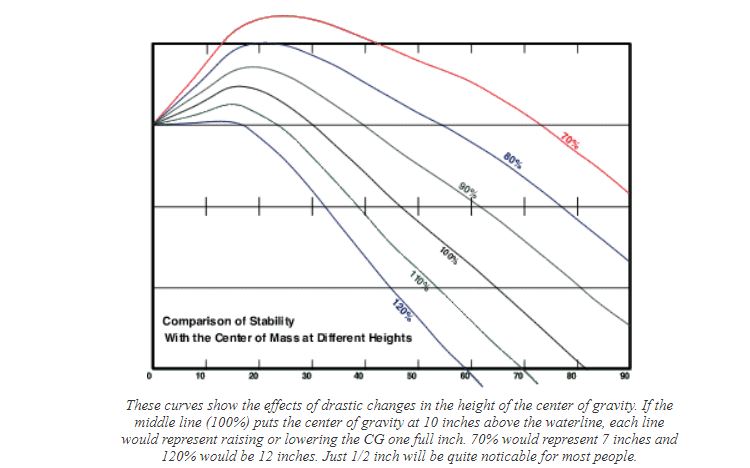
We thought that the cross would be the best idea to attach the seat to the kayak, because in some studies that we have looked on internet we have seen that the more triangulation the more strength the seat will have. When you sit, the part of the seat that is holding your weight is the middle. I few attach the seat to the kayak with two parallels bars all the weight is being hold by the seat while if you use a cross the weight is divided into the four end points of the cross.
The surface encompass more space in the centre of mass when you sit on a chair, that means that the weight is being hold by the centre and not the sides.
If we applied and static passive force that represents the weight of a person, the chair starts to make an effort of compression in its smaller area, which is the section that corresponds to the leg. The forms redistributed the weight and it responds generating an effort of compression lead to the nucleus of the leg. However due to this force is reflected is going to be annulated and will not generate a cut. So in order to decide the materials for the seat it is important to select one that can handle normal compression resistances.
To be able to do the calculations of the forces it is necessary to know the weight of the person, based in the mass, and it is necessary to know the diameter of the leg, the hook of the seat, where is going to be the theoretical failure.
s=N/A
The letter sigma(s) would be the resistance of the material, N is the weight in Newtons of the person and A is the area of the smaller section of the hook, obtained using its diameter.
Once the resistance is being calculated we should compare the result with the values of the materials.
That’s why instead of doing the whole seat out of carbon fiber, we decided to use aluminium for the hooks so the seat can hold the weight of a person without any problem.
